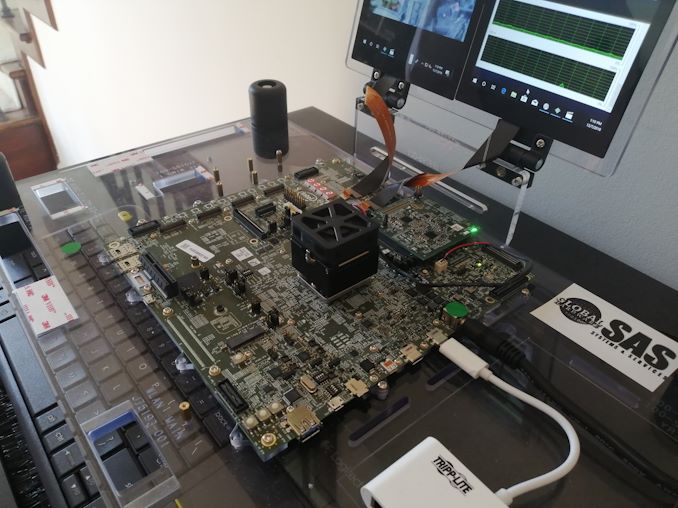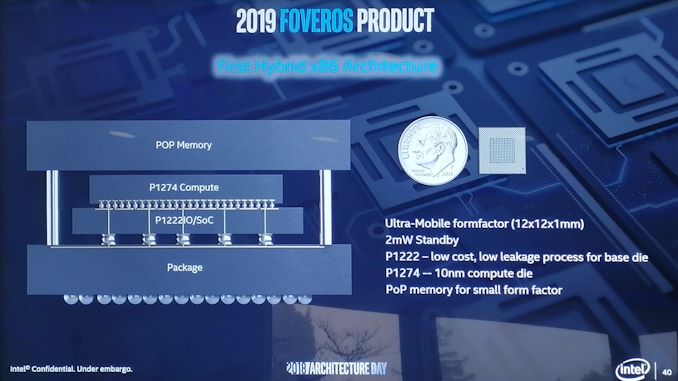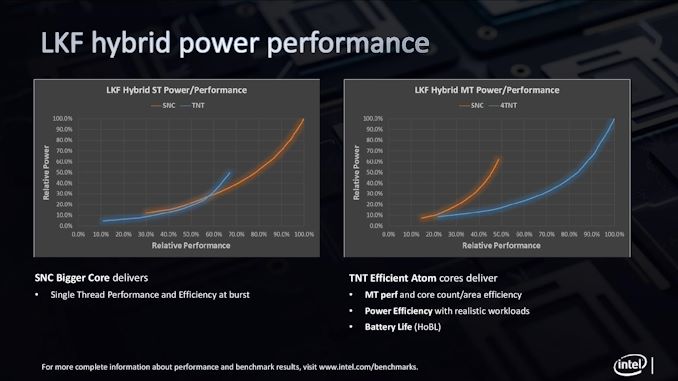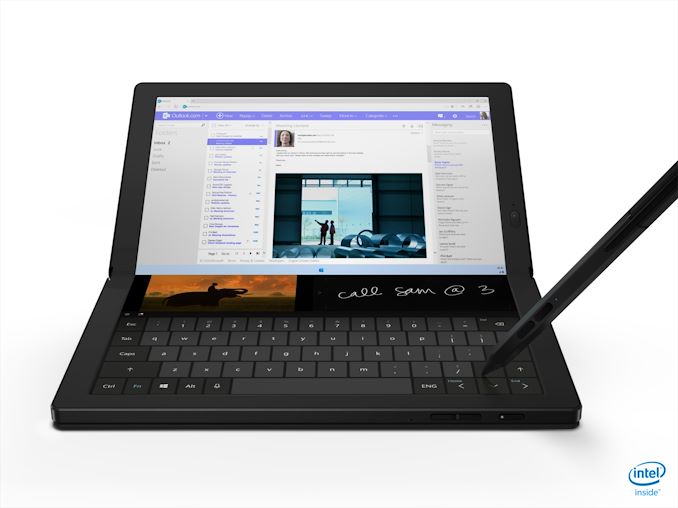Intel Discloses Lakefield CPUs Specifications: 64 Execution Units, up to 3.0 GHz, 7 W
by Dr. Ian Cutress on June 10, 2020 11:00 AM EST
Over the past 12 months, Intel has slowly started to disclose information about its first hybrid x86 platform, Lakefield. This new processor combines one ‘big’ CPU core with four ‘small’ CPU cores, along with a hefty chunk of graphics, with Intel setting out to deliver a new computing form factor. Highlights for this processor include its small footprint, due to new 3D stacking ‘Foveros’ technology, as well as its low standby SoC power, as low as 2.5 mW, which Intel states is 91% lower than previous low power Intel processors. Today’s announcement comes in two parts: first, the specifications.
Intel will debut these two SKUs in its first generation of Lakefield. These CPUs will find homes in premium, always-connected laptops, such as the Samsung Galaxy Book S expected in markets this month, the Lenovo ThinkPad X1 Fold, coming later this year, and in the Microsoft Surface Book Neo.
Both SKUs will feature one big ‘Sunny Cove’ CPU core, along with four little ‘Tremont’ Atom CPU cores. Both sets of cores will have access to a 4 MB last level cache, although Intel has not yet disclosed what sort of cache this is.
Meanwhile on the graphics front, Intel is integrating a Gen11 GPU with 64 execution units, the same number of EUs as on Intel's Ice Lake processors. Interestingly, the iGPU is clocked about half as high as usual for an Intel GPU, with clockspeeds peaking at just 500 MHz – suggesting that Intel is going wide and slow to increase graphics performance. Both CPUs will be rated for a TDP of 7 W.
| Intel Lakefield Processors | ||||||||
| AnandTech | Cores | Base Freq |
1C Turbo |
nT Turbo |
Gen11 IGP |
IGP Freq |
DRAM LP4 |
TDP |
| i5-L16G7 | 1+4 | 1400 | 3000 | 1800 | 64 EUs | 500 | 4267 | 7 W |
| i3-L13G4 | 1+4 | 800 | 2800 | 1300 | 48 EUs | 500 | 4267 | 7 W |
Intel confirmed to us that the base frequency is the unified frequency across all five cores, and the single core turbo frequency applies only to the big Sunny Cove core. Support for LPDDR4X-4266 is a notch above the memory controller in Ice Lake, which only runs at LPDDR4X-3733, and the memory speed will likely be a big boost to performance.
In order to enable these processors in a small 12mm x 12mm footprint, Intel is using its 3D stacking technology, called Foveros. This means that the logic areas of the chip, such as the cores and the graphics, sit on a 10+ nm die, while the IO parts of the chip are on a 22nm silicon die, and they are stacked together. In order to make the connections work, Intel has enabled 50 micron connection pads between the two silicon halves, along with power-focused TSVs (through silicon vias) in order to power the cores on the top layer.
Intel lists the TDP for these chips at 7 W, although the company has not disclosed the turbo power limits for the chip. As mentioned above, Intel hasn’t disclosed how the cache works. In the initial diagrams, we were shown that PoP memory would be added on top, and while Intel hasn't offered further details there, we know from last month's Samsung Galaxy Book S reveal that there will be (at least) 8GB SKUs using LPDDR4X.
We have big questions as to how each of the cores will work, given that by default they support different instruction sets – Intel hasn’t provided information on this at this time. Intel has stated that the scheduling of the threads on the different parts of the CPU will occur based on hardware-guided OS scheduling, although again Intel hasn’t gone into the details of its hardware tracking and enablement on how this is done. In the demos we have seen, Lakefield will use the Tremont cores for almost everything, and only call on the Sunny Cove core for user-experience type of interactions, such as typing or interacting with the screen.
Intel is planning a post-announcement briefing for press to ask questions, which means that this announcement is coming in two parts. This is the information we’re being given beforehand, and we will update you with the details from the post-announcement briefing. As part of this process, we’ve exclaimed to Intel how this way around of presenting details to the press is frustrating – firstly for readers, as you all will have to come back if you want to find out what more Intel tells us later today, but secondly for us, as press, who will have to scramble to jump on the details and decide whether to write fast and miss details, or write slow and miss the wave of traffic.
One thing we can confirm in advance – the Sunny Cove does not appear to be AVX-512 enabled. Intel’s initial press release states that AI workloads occur on the CPU; given the extra power draw required for AVX-512, this is probably a good thing.
More information out of Intel’s post-announcement press-briefing will come later today.














78 Comments
View All Comments
close - Wednesday, June 10, 2020 - link
For an arbitrary definition of "decent" :). I used Windows on m3 and m5 CPUs, similar clocks, similar power envelope, and 2 (big) cores (4 threads) rather than 1+4. And it's the kind of experience I *do* wish on people I strongly dislike. I doubt that in the past 18 months Intel made leaps and bounds but I'm curious if the 4 small cores can compensate for the missing big core and presumably the 2 additional "big" threads.yeeeeman - Wednesday, June 10, 2020 - link
I don't know what are your expectations from a tablet but I have an atom z3735f tablet from 2014 and for YouTube, Facebook, word, PowerPoint and even some older games it works very well. I can't see why you would be unhappy with a 5 core chip, that has the smaller cores with ipc comparable to ivy bridge, one big core that can boost to 3ghz for the special cases when you really need some extra performance but generally for what people usually do on a tablet this chip will be more than up to the jobdotjaz - Thursday, June 11, 2020 - link
So is 8CX, what's your point then?Spunjji - Tuesday, June 16, 2020 - link
I believe you might be right. I have a couple of devices with Ivy Bridge dual-core 15W CPUs running at around 1.8Ghz, and they're intolerably slow when it comes to tasks like Windows updates. With an extra pair of cores handling background threads and that Sunny Cove core up front, this might actually do a decent imitation of a usable device for light workloads - especially with that GPU, which is substantially larger than anything previously attached to this level of CPU design from Intel.PaulHoule - Wednesday, June 10, 2020 - link
This is telling: "Lakefield will use the Tremont cores for almost everything, and only call on the Sunny Cove core for user-experience type of interactions, such as typing or interacting with the screen."It's a real problem today that computer applications do not feel responsive; it's a problem on top-of-the-line machines, but it is worse on weaker machines. A better CPU has something to do with perceived latency, but more often it is that the embedded flash is slow, doesn't support trim, the network seized up for 5 seconds, ...
Intel has identified the problem but it is a software problem as opposed to hardware problem. I'd like to have a "computer user's bill of rights" which will always let me know if an operation in progress is progressing or not. For instance on a very powerful Win 10 laptop I might start an application such as PyCharm, Firefox, or CMD.exe and wait anywhere from two to twenty seconds to have any visual indication that the computer was still working on starting it. If you get impatient you might try it more than once and then have five windows pop open all of a sudden.
Of course we love to complain about Electron applications but it is astonishing how long it takes Adobe products, mostly written in C++, to start. Or even a little CMD.EXE program that uses a 50k binary for that matter. The Linux command line is as snappy as it was in 1994, but X Windows and the ecosystem around it is insufferable. MacOS at least gets the font metrics right.
LiKenun - Wednesday, June 10, 2020 - link
The root of the problem is that applications have to do all of this extra work at all before showing a usable interface. Just-in-time compilation, loading a bitmap for the splash screen, loading all of the plug-ins at start-up (even the ones I never touch for the lifetime of the process), checking license/activation, fancy UI that is totally out-of-place with respect to the native UI, etc.As my boss liked to say at meetings, “Why do I have to wait for these delays? The whole day’s schedule is there. Just get all the things ready to go so that I can have them when they’re needed.”
I suppose this is why some operating systems have begun to pick some of the low-hanging fruit like pre-compilation and pre-loading executable code based on learned usage patterns. But single-threaded performance isn’t improving as fast as it did in the previous decade. Developers should be focus on cutting out the pork from UI (which is not amenable to parallelization).
lmcd - Wednesday, June 10, 2020 - link
Size of app on disk and loading speed don't have that much correlation given the bandwidth available to apps at every point in loading the app. If you're getting 2-20 seconds for firefox launch you should do a reinstall. Cold start Firefox takes me ~2s or less, reliably.Pycharm, like all IntelliJ products, depends on OpenJDK. This sort of tradeoff enables running on Mac and Linux easily while slowing their load time. Again, though: I have an upper midrange laptop. 2s for IntelliJ. There's something wrong with your install or you're incredibly impatient and can't count time. Ryzen 2700U, 8GB RAM, Evo 970 SSD.
If CMD.exe takes 2-20s please just reinstall Windows lol.
edzieba - Friday, June 12, 2020 - link
It's nut a software problem, it's a fundamental mathematical problem: good ol' Amdahl's Law. If you need to perform X tasks one after the other to go from capacitive touch input to display update, and those tasks need to be performed in sequence (i.e. you can't start rendering the update before you know where on the screen the input occurred), then more cores will never help you. The only way to reduce that total sequence time is to run the serial sequence faster.PeachNCream - Wednesday, June 10, 2020 - link
It would be interesting for Intel to shed the larger core and then just run for Atom cores and maybe ~32 iGPU EUs for smaller, conventional notebooks that are not attempting to impress on premium design features. 7W TDP is a bit too high for comfortable, passively cooled usage. ~4W at max turbo and full load of all CPUs + GPU would make for a better fanless experience.lmcd - Wednesday, June 10, 2020 - link
7W is absolutely an easy target for passively cooled usage. It's only boosting past 7W that would run into issues.I've owned two passively cooled m3/m5 laptops. The m5 ended up being more like a tablet, and that was a bit too excessive. Frankly though that was due to other tradeoffs -- it was somehow user-accessible which meant there was no battery. The m3, which had more space in the design, was well able to cool its chip and keep the unit powered.
Given the peak power is 7W, but the average power should be much lower, this looks like an excellent chip. I'm excited.